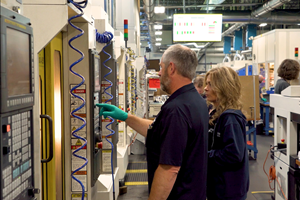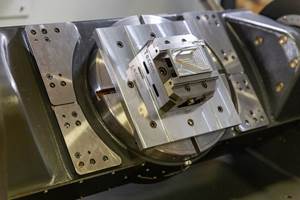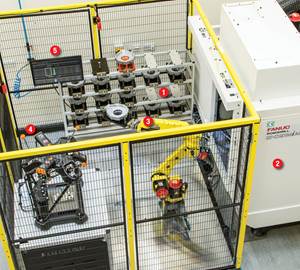The CNC as Nerve Center
In the move to data-driven manufacturing, communication and data transfer have to be possible in all directions. The machine control is a sort of "hub" in the manufacturing environment.
Share


Hwacheon Machinery America, Inc.
Featured Content
View More






Economical manufacturing demands an efficiently working process chain. It must seamlessly connect the design, programming, simulation, production planning and production stages. The machine tool control unit plays a pivotal role, as it is located at a central position within the process chain. In a very real sense, it is positioned to be the nerve center for data-driven manufacturing.
In the move to data-driven manufacturing, communication and data transfer have to be possible in all directions. After all, the goal of all these measures and investments is to increase efficiency in the workshop. The essence of data-driven manufacturing is achieving better decision-making by basing it on reliable, factual information.
The machine control is the last data processing link before the machine transforms digital bits and bytes into mechanical motion, makes chips, and ultimately produces the desired workpiece. It is truly the hub in the emerging digital manufacturing environment.
During production at the machine, a wide variety of additional data and information is generated that is needed elsewhere along the process chain. This includes information on changes made to the part program on the control as well as data for quality assurance. All these details need to be continuously updated and made available to all who are involved in the manufacturing process.
To transfer this digital knowledge quickly and reliably, the universal availability of electronic production documents is indispensable. This information includes technical drawings, CAD data, NC programs, cutting tool data, work instructions, tooling lists, inventory data and so on. Digital product data such as photos or test reports that are generated during the manufacturing process also have to be passed on.
What sort of features and capabilities ought a CNC have to meet these requirements? At least one control builder, Heidenhain, has made these requirements for supporting data-driven manufacturing a top concern in the design and configuration of its TNC 640 control. It incorporates some of the representative features that make a CNC well-placed to serve as the nerve center for data-driven manufacturing.
For example, to integrate this control into the process chain and access the desired data on the control’s user interface, two different solutions are available. One solution comprises the standard features of the control, which provide access to manufacturing process data right at the control through a CAD viewer, a PDF viewer and the Mozilla Firefox Web browser. Viewing with the browser requires no separate program installation. The operation of Web-based documentation software or ERP systems is as feasible here as access to an email inbox. For example, if essential data such as a DXF file is missing, the customer can directly email the DXF file to the operator.
A more advanced option for integrating this control into the process chain is a remote desktop manager. One button on the control keyboard switches between the control screen and the screen of a computer in the local network or of an industrial PC mounted in the machine’s electrical cabinet. From the control, machine operators can access all the usual applications for managing, documenting and visualizing. CPU-intensive CAD/CAM tasks do not affect CNC machining or machine performance.
A common cause of production delays is incomplete dimension data in drawings. In this case, the machine operator can simply load the CAD model on the control. The required data and information can thus be quickly provided to the machine, even if the design engineers are currently not available.
In another example, say a component for a time-critical job has been programmed in the shop’s CAM system. However, the machine operator receives a notice from the cutting tool supplier or checks the latest online tooling database to find that the tool to be used actually permits a higher feed rate. To improve efficiency, the operator can open the CAM application at the control, enter the updated feed rate and generate a new NC program. In the CAM system, the new feed rate values are stored centrally and are visible to everyone involved in the process.
When evaluating a new machine, every shop must consider not only the fitness of the control for maximizing the capabilities of the machine, but also the fitness of the control as a data hub—truly a nerve center—for data-driven manufacturing.
Related Content
Shop Quotes Smarter, Works Harder with Machine Monitoring
Temco first installed MT-LINKi to optimize quoting. Now, the software helps the shop optimize its machines — and machine purchases.
Read MoreDiving Deeper Into Machine Monitoring Data
Data visualization is the first step in using machine monitoring data, but taking it to the next level requires looking for trends within the data.
Read MoreProcess Control — Leveraging Machine Shop Connectivity in Real Time
Renishaw Central, the company’s new end-to-end process control software, offers a new methodology for producing families of parts through actionable data.
Read More5 Stages of a Closed-Loop CNC Machining Cell
Controlling variability in a closed-loop manufacturing process requires inspection data collected before, during and immediately after machining — and a means to act on that data in real time. Here’s one system that accomplishes this.
Read MoreRead Next
Registration Now Open for the Precision Machining Technology Show (PMTS) 2025
The precision machining industry’s premier event returns to Cleveland, OH, April 1-3.
Read MoreBuilding Out a Foundation for Student Machinists
Autodesk and Haas have teamed up to produce an introductory course for students that covers the basics of CAD, CAM and CNC while providing them with a portfolio part.
Read More5 Rules of Thumb for Buying CNC Machine Tools
Use these tips to carefully plan your machine tool purchases and to avoid regretting your decision later.
Read More












































